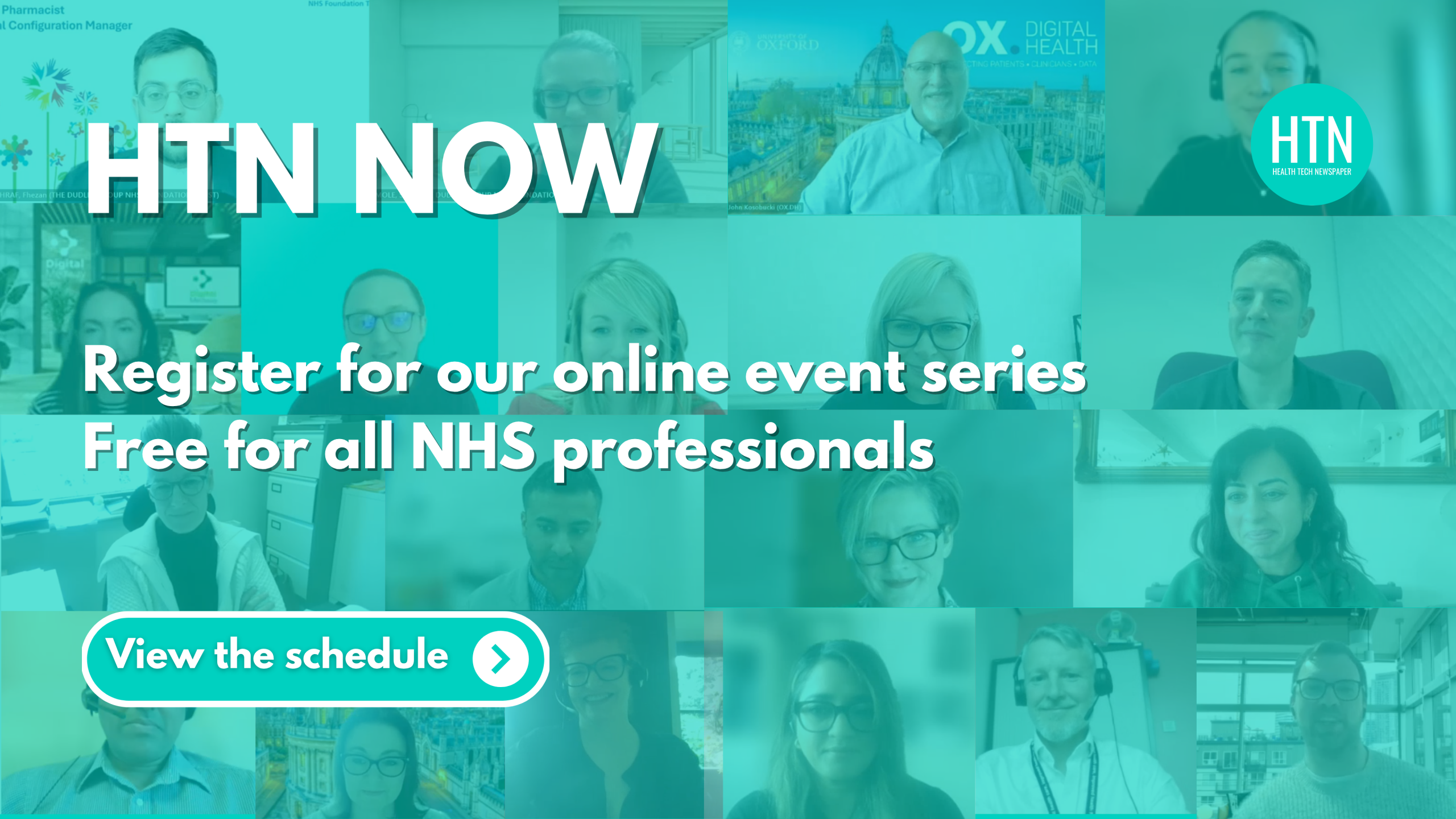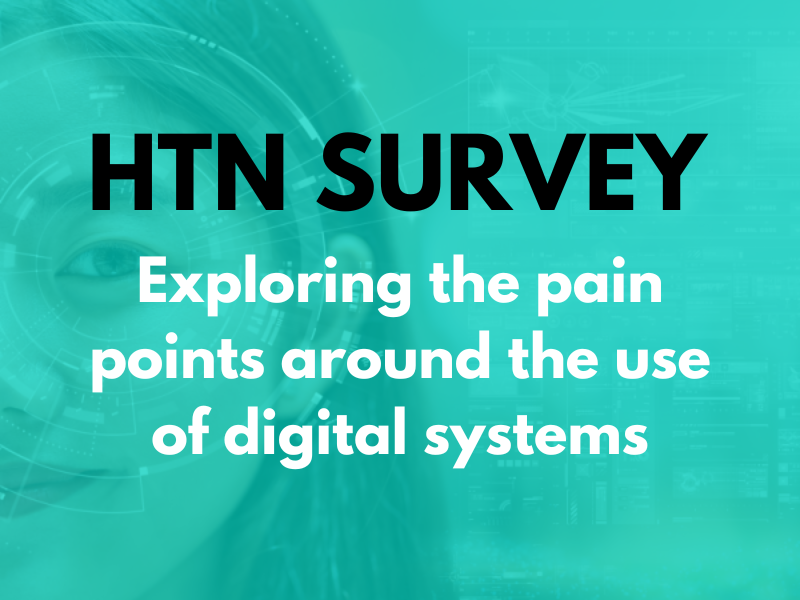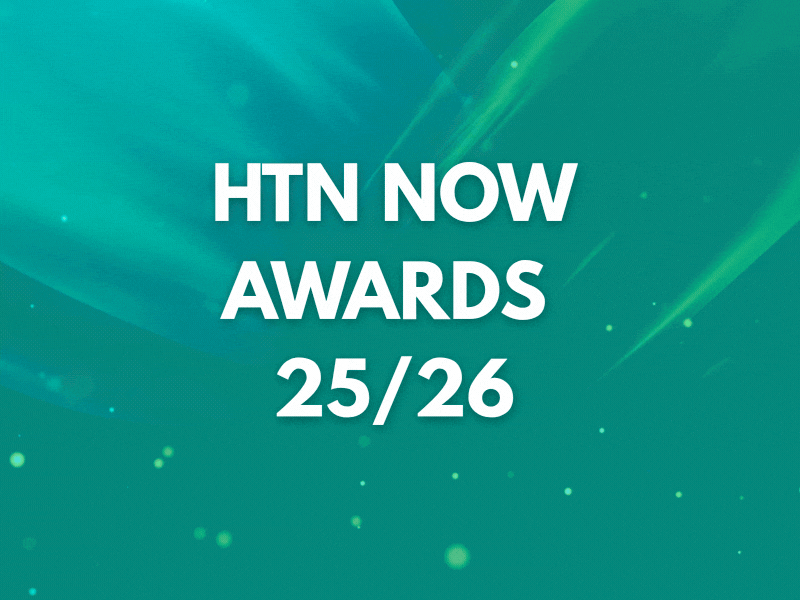We were joined for a practical HTN Now webinar taking a deep dive into AI in health and care by expert panellists Peter Thomas, chief clinical information officer and director of digital development at Moorfields Eye Hospital; Sally Mole, senior digital programme manager – digital portfolio delivery team at The Dudley Group; and Ananya Datta, associate director of primary care digital delivery, South East London ICS.
The session shared approaches, best practices, challenges, successes and learnings for the practical implementation of AI technologies across health and care, with our panel offering insight into current work, future plans, and ongoing collaborations in areas such as Ambient AI.
Introductions and current focuses
Peter talked about his role as a consultant paediatric ophthalmologist, CCIO and director of digital development at Moorfields, and his current focus on helping to create a virtual hospital model to allow the trust to share its expertise more widely. “That links in with the work I’ve been involved in with NHSE as the digital clinical lead for eye care and supporting the NHS’s online hospital model,” he shared.
Moorfields has done a “huge amount” early in the AI pipeline, according to Peter, who shared examples including a collaboration with Google DeepMind. This partnership paved the way for the development of a data research platform called INSIGHT, that currently holds around 35 million ophthalmic images, as well as associated diagnostic and metadata as the biggest bioresource for ophthalmology in the world. Elsewhere, the trust has had a “steady stream” of publications on AI use in diagnosing and supporting eye disease and has more recently been focused on oculomics, using AI to diagnose diseases like Parkinson’s and Alzheimer’s from scans of the eye, up to seven years ahead of when they would normally be picked up.
“Recently we made the transition toward trying to turn those projects into products,” Peter elaborated, “like with our spin-out Cascader, which is developing some of that work through to regulated products that can be used in optometry practices.” Another area of focus is deploying AI into the frontline across the trust.
Ananya shared some details of her remit as associate director for digital service delivery in SEL. “We support around 200 practices and a population of 2.1 million,” she told us, “and my portfolio also includes wider support to community pharmacy and to care homes.” There are a lot of things happening in the primary care space relating to new products or technologies available to be trialled, she stated, “and we need to be sure those are safe for use”. Measures have been put in place to ensure platforms in use in general practice are now evaluated by the ICB’s technical team, the IG team, and clinical safety officers.
Microsoft Copilot is being trialled with GP practices, working with NHSE, Ananya went on, “But that is for administrative rather than clinical purposes, and it was clear from the scope that if we roll it out for a year working with the national team, it will be focusing only on how the admin burden can be reduced in general practice”.
Sally discussed her earlier career in community and hospital pharmacy before taking a “sidestep” into digital when starting at Dudley eight years ago. “I started out doing clinical configuration, then worked my way through to project management, and now programme manager,” she explained. “I’ve been with Dudley throughout their digital journey in terms of EPR and multiple other complex projects, and we’ve got a couple of AI solutions across the organisation, including RapidAI and Ambient Voice pilots.”
Clinical safety
In SEL, an area of focus at present is helping to support practices that might not have the resources or capability to deal with the clinical safety aspect of AI, Ananya said, with the ICB choosing to evaluate four or five key products that practices plan to, or have started to, use. “We have three digital clinical safety officers who have undergone CSO training and so on, and we have our primary care CCIO looking after the clinical safety assurance of any digital product. It’s very time-consuming to prepare a hazard log and then two or three documents, and we’ve requested the practice to work with one of the partners who would be able to automate that hazard log generation and documentation, doing workshops and gathering information from each practice.”
When practices provide feedback, this AI tool will gather that and try to read from the DCB0129 or the hazard log of the supplier, to provide a base from to start the preparation of the clinical safety documentation, Ananya continued. “Once this is done for maybe 100 practices using the same product, their input and the supplier’s hazard log will build ICB-level clinical safety documents which our clinical safety officers will review and provide feedback on to send back to the company, who will then generate practice-level clinical safety assurance documents.”
Practices are also being asked to focus on building the skills of clinical safety officers through training provided at national or regional level, to allow them to take ownership of the process moving forward, according to Ananya. “We have defined a process now, and that was sent out to general practice last month to be worked on from October onwards.”
At Dudley, clinical safety processes are already embedded within governance processes, Sally shared, with the relevant teams assigned to perform those duties. “My role is to make sure that as part of the governance process, they’re involved in projects at the right times, and that’s included in the portfolio checklist, but clinical safety is done multiple times throughout the process.” That includes in the early stages in terms of scoping and then later on once a solution is selected and use cases are outlined.
“We run user acceptance testing with real-life patient scenarios to make sure the final solution is going to work in practice,” Sally said, “and as part of that we look at whether there is a clinical safety risk, the potential impact, and also whether there’s a chance we could break business processes – either of those things could mean a change is required before we go live.” Avoiding complacency and the belief that the AI is always going to be right is essential, she added, “and you need a human to be responsible for making sure the information is correct”.
On training, Sally noted the importance of taking staff along on the journey and the success Dudley has had with suppliers being involved in the clinical environment to work with and train users on the solution, simultaneously learning about the clinical aspect of workflows to ensure it is effective across use cases. “We’ve learned that environmental factors can play a role, as we’ve had a couple of pilots which yielded different outcomes in different areas due to differences in workflows or clinical settings. One provider may not be suitable for all practices, and I think part of the clinical safety is honing in on what the solution has to offer and the benefits in terms of those areas.”
Moorfields has “quite a large” digital clinical safety team, Peter shared, “and we’ve wanted to embed that at quite a senior level”. A clinical director for digital safety has been appointed to oversee a team of clinical safety officers, along with a data analyst, to help identify risks by examining the data following a go-live. “It’s difficult to maintain vigilant human oversight – when you look at lifeguards, they rotate every 25 minutes, and that’s because when you’re overseeing something where bad things rarely happen, you tend to lose attention after a short period,” he considered. “So even if we build a system with human checks, we have a larger problem that even with those, humans will lose interest in checking for errors.”
Issues arise when comparing AI solutions to a non-existent gold standard, explained Peter, “where we’re assuming that in the real world there are no mistakes. In reality, we know the quality of clinical documentation is incredibly poor, with lots of things not documented, so I think part of assessing the risk of these platforms has to be understanding that it’s not replacing a zero-risk situation.” Maintaining that understanding and acceptance that it’s never going to be 100 percent flawless is key, and “we need to be pragmatic when comparing with what’s happening in the real world”. For ambient voice, he suggested having a database of recorded clinical conversations to use as a reference for tools to run through, to help establish the error rate and avoid duplication with lots of different pilots.
Piloting Ambient AI
When it comes to piloting Ambient Voice Technology (AVT), Moorfields started by trying to work out the benefits in principle. “You probably release a lot more benefits when you integrate it directly into your EPR than as a standalone solution, and without having to copy and paste across, so we’ve had to do quite a lot of work to compare the two scenarios,” Peter said. “I think about 85 percent of users are reporting a time saving, along with a much lower rate of diverting attention away from the patient to document things, which is a really positive outcome.”
In some clinics, AVT has saved seven minutes per consultation, according to Peter, “this stacks up pretty quickly and means people getting away on time and not doing unpaid overtime that contributes to burnout”. The next step is to make sure it is producing structured data, he noted. “There are so many of these products around that it would be really lovely if we had a common understanding of what good output data from a clinical consultation looks like, which would play into having a database of synthetic consultations to benchmark performance.” In a couple of years it will be interesting to see whether information can flow both ways, telling clinicians what is in the EPR as well as sending data back into it, he considered.
In Dudley’s case, AVT has been rolled out across SDEC, inpatients and outpatients, and is also in use as a dictation tool to help reduce the letter backlog. “We’ve done a pilot with clinical coding, looking at the patient journey all the way from admission through to discharge, looking at ward rounds, discharge letters, admission and triage documents, and that’s come back showing AI effectively beats the human every single time, including the coding it pulls out,” Sally said. The trust has integrated an AVT solution into its EPR, with unique coding to make sure information flows into the correct documentation, with plans to expand that to all documents within the EPR.
Sally’s team is also looking at integrating across other systems such as the community portal, and has just done a proof of concept for that, she said. “A lot of the issues we had to start off with were not just having to copy and paste, and getting data to be structured and flow into the right fields to allow for extraction at the other end. We’ve also started looking at formats that can be automatically populated, and we’ve got predefined templates for where there’s a lot of repetitive information. We’ve got discharge summaries being sent to GPs in real time; we’re looking at GP referral letters, patient letters, clinic notes, and how that clinical coding feeds into the EPR.”
Efficiency savings include an increase of 66 percent in letter throughput for secretaries and a reduction of 6.1 minutes in SDEC consultations that released 221 clinical hours per month, Sally shared. Feedback on the ground was positive, and the solution is now being used in rheumatology to send real-time letters to the GP, which will remove the backlog, she continued, “so once we’ve done the business case and that goes through, we’ll eradicate some of those secretarial processes because they will be done in real time by the clinician and sent straight to the GP to reduce the delay back to primary care”.
Ananya talked about SEL’s Copilot work in primary care, with the ICB initially receiving approval for around 300 licences. “A challenge we faced initially was that the infrastructure needs to support Office365, etc.,” she said, “so we have worked on planning the rollout to ensure practices are getting that modern infrastructure along with the Copilot licences.” The pilot is due to end by March 2026, and the ICB is currently working with the regional and national teams to understand the benefits, the business case, and the plan for next year.
The pilot is restricted to administrative tasks, which means the benefits are “very different” to other solutions that might be used in clinical consultations, Ananya explained. “We’re evaluating a much wider spectrum in terms of how it reduces admin workload, and one of the things I’ve heard from practice managers is that it has helped them with contract documents, giving them the gist very quickly and letting them know what they need to do.” Feedback from corporate users has also been that the solution is helping to “significantly” reduce their workload, offering meeting preparation, an overview of pending tasks, and relevant document retrieval. Once the outcomes are published, SEL will decide the next steps, she concluded.
Looking ahead
Looking to the future, Peter spoke of hopes that projects like Cascader will bring “huge amounts of benefit back into the NHS”, highlighting that “whilst it’s early days, we hope to have our first medical device regulated products within 18 months or so”. In 10 to 20 years, scans of the eye could help reveal information about general health, he said, “and prevent an awful lot of people from developing serious complications for organ systems that have nothing to do with the eye, apart from showing up features or markers of disease there”.
On an audience question covering AI policy, Perter commented: “Though we’re conscious there is some benefit in viewing AI as being something different, there’s also value in seeing it just as another type of technology or software. We’re used to the concept of software as a medical device – we’ve had algorithms that interpret our images that aren’t based on AI for a long time.” He noted that it could be better to have a policy for clinical IT systems and software as a medical device, and to deal with AI as part of that.
Sharing some of the future plans for Dudley, Sally shared her thoughts that diagnostics is likely to be a big focus in the next three years, and details of CDS iRefer, which is going to be integrated with primary care in the next six months. “It can be a bit boring to talk about AVT and documentation, but there’s a much bigger piece of work for the future in population health and analysing data to put preventative measures in place. With that in mind, we’ve partnered with Aston University and set up a RADAR (Research Analytics Data for AI Redesign) lab looking at things like early identification of ventilation-associated pneumonia to try and identify patients at risk.”
To allow this kind of preventative work to take place, it will be important to ensure the accuracy of the trust’s data, Sally went on, “and I think that’s going to be a big challenge across the NHS, which makes AVT really important, because it does capture much more comprehensive clinical information and it can put that in the right places, support coding, and help streamline that data for us to do the research cases and look to improve population health moving forward”.
Ananya talked about work around AI-assisted triage through the NHS App. “As neighbourhood health is being developed, we will see more planned care being done proactively for long-term care and frailty patients using AI,” she considered, “and one of the key areas we’re also seeing is around self-care or self-referral.” The biggest challenge is workforce and getting the skills and understanding of AI in place, due to the speed with which the technology is being developed, she noted.
“We’re trying to enhance the basic digital skillset across all employees, partnering with our training hub, and we do an evaluation each year, a digital maturity assessment of each practice, to find out where they need the support so we can tailor that training,” Ananya shared. This has identified a need for support with IG assurance and cybersecurity, as well as selecting the right technologies. “Going forward digital maturity will be a key focus for primary care to build the capability and skillset in general practice.”
We’d like to thank our panel for taking the time to share these insights with us.






